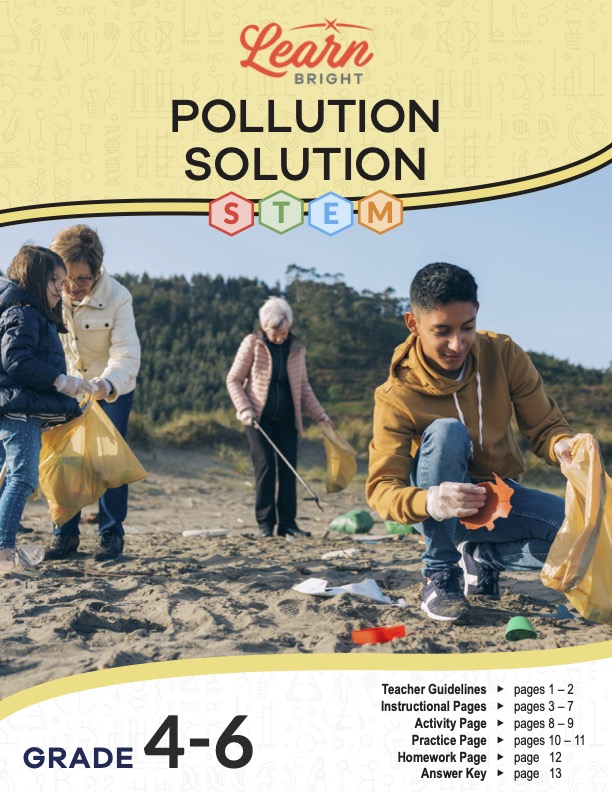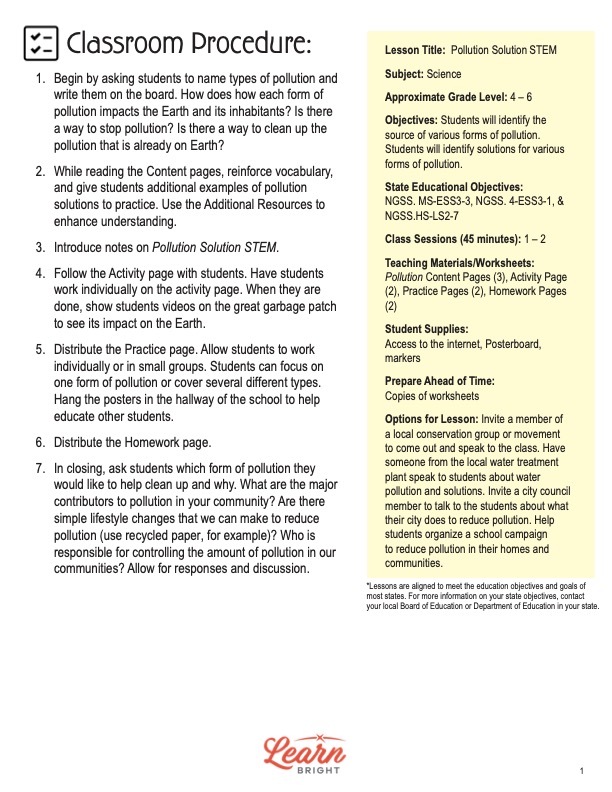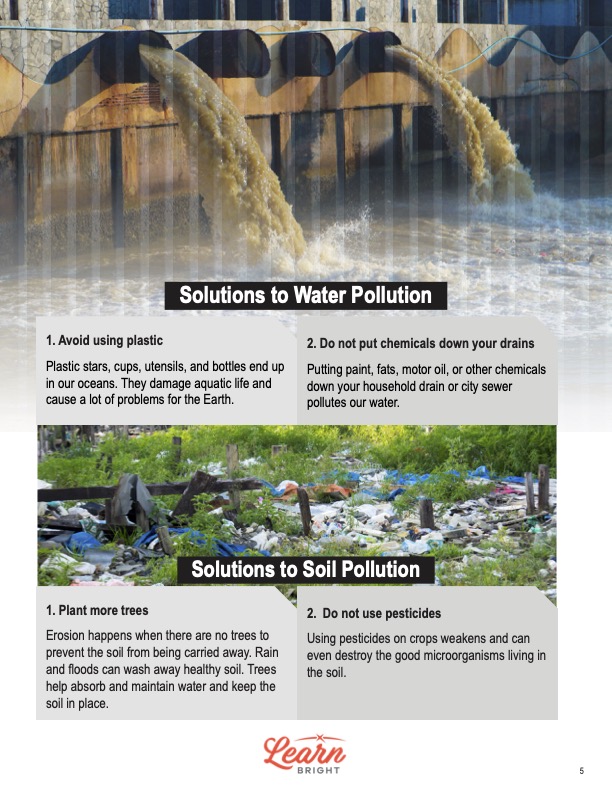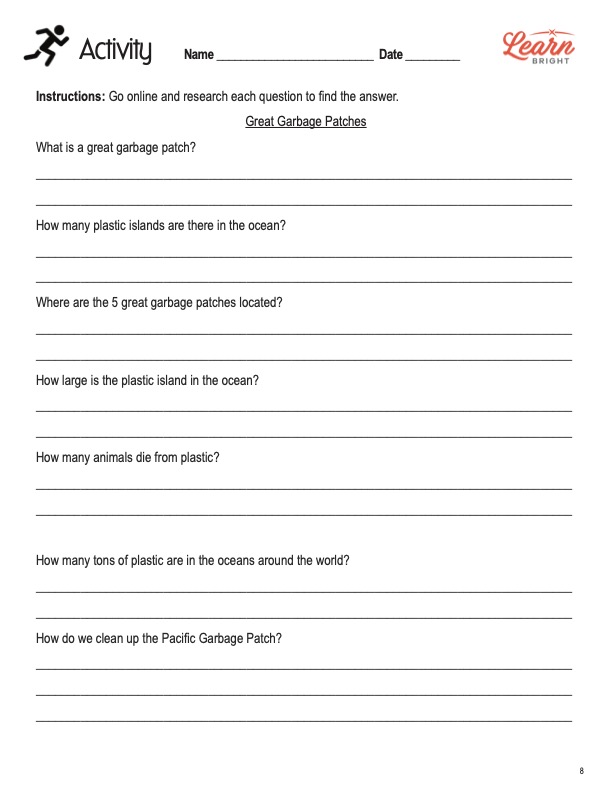Description
What our Pollution Solution STEM lesson plan includes
Lesson Objectives and Overview: Pollution Solution STEM explores the sources of various forms of pollution. Students will discover the effects of pollution and identify solutions for different types. They will specifically learn about five types of pollution. This lesson is for students in 4th grade, 5th grade, and 6th grade.
Classroom Procedure
Every lesson plan provides you with a classroom procedure page that outlines a step-by-step guide to follow. You do not have to follow the guide exactly. The guide helps you organize the lesson and details when to hand out worksheets. It also lists information in the yellow box that you might find useful. You will find the lesson objectives, state standards, and number of class sessions the lesson should take to complete in this area. In addition, it describes the supplies you will need as well as what and how you need to prepare beforehand. This lesson simply requires poster boards and markers.
Options for Lesson
You will find several suggestions for additional ideas and activities in the “Options for Lesson” section of the classroom procedure page. One idea is to invite a member of a local conservation group or movement to speak to the class and answer their questions. You could also have someone from the local water treatment plant speak to students about water pollution and solutions to those problems. Invite a city council member to talk to the students about what their city does to reduce pollution. One more idea is to help students organize a school campaign to reduce pollution in their homes and in their communities.
Teacher Notes
The teacher notes page provides an extra paragraph of information to help guide the lesson and remind you what to focus on. The blank lines on this page are available for you to write out thoughts and ideas you have as you prepare the lesson.
POLLUTION SOLUTION STEM LESSON PLAN CONTENT PAGES
Types of Pollution
The Pollution Solution STEM lesson plan has five content pages. To start off, it explains that pollution affects everyone on the planet, including the animals on land and in the sea. Some pollution is man-made, and other pollution comes from natural sources. (Natural sources are sources that occur in nature.)
When there is a forest fire or volcanic eruption, large amounts of harmful gases, like ozone and sulfur dioxide, release into the atmosphere. These gases are called greenhouse gases, and they increase global warming. Students will discover that some animals contribute to air pollution, too. Methane is a harmful gas released into the air when cows or sheep burp or break wind. Because humans herd these livestock, there are many more than would naturally be present on the earth.
As citizens of the earth, we can work to stop all forms of pollution. There are many possible solutions and things that we can individually do to prevent more pollution. Some of these are very simple and require minimal changes to how we do things already. For example, if everyone drives less often or carpools, we could eliminate much of the air pollution in large cities. Another way is to look for items we can recycle. Doing so can help keep them out of landfills and from decomposing into dangerous chemicals that get into the soil and water.
Air and Water Pollution Solutions
The lesson provides four specific ideas to help lower the amount of pollutants in the air. The first is to replace fossil fuels with alternative energies such as solar, wind, or geothermal. Renewable energy sources yield less air pollution because they harness the earth’s power to make electrical and heat energy for humans.
Second, use energy responsibly. We can reduce pollution by reducing our consumption of energy. Developing responsible habits, like turning off lights and electrical devices when aren’t using them, can reduce pollution. The same is true of the third idea: changing our mode of transportation.
If everyone used their vehicles less often, there would be less air pollution. People could carpool or take public transportation where available. Cities could add public transportation systems to cut down on the number of cars on the road that produce pollution. Or we could design cars that use alternative fuel sources!
The last idea is to use “green” buildings. Designing eco-friendly buildings is a great way to reduce our carbon footprint. We can create structures to be environmentally responsible from start to finish. One way to do this is to build walls with hay and straw inside of them.
Students will then learn two ways to reduce water pollution. We should avoid using plastic and not flush chemicals down our drains. Plastic straws, cups, utensils, and bottles end up in our oceans. They damage aquatic life and cause a lot of problems for the earth. Putting paint, fats, motor oil, or other chemicals down household drains or city sewers pollutes our water as well.
Solutions for Soil, Light, and Noise
The lesson then provides a couple solutions for soil, light, and noise pollution respectively. To produce soil pollution, we can plant more trees. Erosion happens when there are no trees to prevent the soil from being carried away. Rain and floods can wash away healthy soil. However, trees help absorb and maintain water, and they keep the soil in place. In addition, we could avoid using pesticides since they weaken and can even destroy the good microorganisms living in the soil.
To reduce light pollution, one idea is to turn off road lights in national and state parks at night. Having them on at night interferes with wildlife migratory and breeding patterns. It is difficult for animals and birds to understand when it is day and when it is night.
We should also turn off our own lights. When we do not use our lights, we should turn them off to reduce the amount of light coming from our own home. Additionally, malls could also turn off their lights in the parking lots after hours to minimize extra light emission.
Finally, students will learn two ideas to reduce noise pollution. First, we could wear earplugs to stop unwanted noise. Second, it could help to install double-paned windows. Buildings and homes can reduce noise by installing different types of double-paned windows. These windows filter out extra noise, helping people work, and sleep, better!
POLLUTION SOLUTION STEM LESSON PLAN WORKSHEETS
The Pollution Solution STEM lesson plan includes three worksheets: an activity worksheet, a practice worksheet, and a homework assignment. Each one will reinforce students’ comprehension of lesson material in different ways and help them demonstrate when they learned. Use the guidelines on the classroom procedure page to determine when to distribute each worksheet to the class.
GARBAGE PATCHES ACTIVITY WORKSHEET
Students will research the answers to seven questions related to great garbage patches. They will learn what a garbage patch is and how many exist in the ocean. They will research things like how many animals die from plastic and how many tons of plastic end up in oceans around the world.
INFORMATIONAL POSTER PRACTICE WORKSHEET
For the practice worksheet, students will choose one of the five forms of pollution. They will create a poster that teaches people about solutions for reducing that type of pollution. They must provide at least four solutions.
POLLUTION SOLUTION STEM HOMEWORK ASSIGNMENT
The homework assignment requires students to research the Dark Sky Movement. They will respond to a few prompts on the page about light pollution and its effects.
Worksheet Answer Keys
There are answer keys for the three worksheets in the lesson plan. Given the nature of some of the questions and prompts of the activity and homework assignment, students’ answers may vary. For the most part, however, they should reflect the answers on the keys. Because the practice worksheet requires students to make posters, a sample poster is provided on the answer key. If you choose to administer the lesson pages to your students via PDF, you will need to save a new file that omits these pages. Otherwise, you can simply print out the applicable pages and keep these as reference for yourself when grading assignments.









